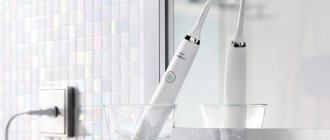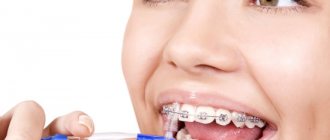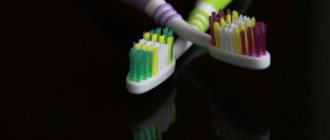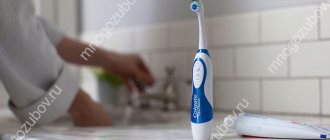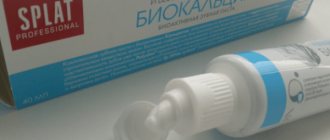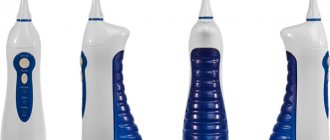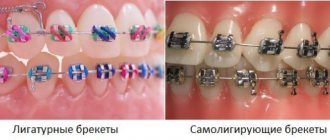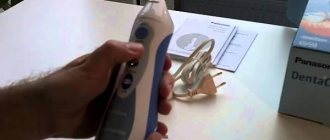Brushing your teeth after installing braces becomes more difficult. Residues of food stuck between parts of the structure cannot be removed by brushing, flossing or rinsing. This problem can be solved through daily use of an irrigator. We'll tell you which device is better to choose and how to use it when caring for braces.
In this article
- What types of irrigators are there?
- Irrigators for braces: orthodontic attachments
- Irrigator for braces - how to choose
- Rating of the best irrigators for caring for braces
- How to use a irrigator to clean braces
Braces are complex metal structures consisting of many small parts. They are placed on teeth to change their position. These orthodontic devices are non-removable. They cannot be removed before going to bed or after eating to clean and rinse. Oral care becomes more difficult. However, neglecting hygiene is dangerous. There is a risk that plaque will begin to form under the braces or carious lesions will appear. A large amount of food accumulates behind the structural elements, which cannot be removed with a regular brush. Special brushes and threads allow you to cope with this problem, but they take a lot of time. It is much faster to get your braces in order by cleaning them from food debris with an irrigator.
Oral cleaning devices are available with various attachments: standard, tongue, massage, periodontal and orthodontic. Let's try to figure out which irrigator is best to use for braces. First, let's talk about the main features of these devices.
What types of irrigators are there?
An irrigator is a device that, by creating a pulsating stream of water, cleans the teeth, gums and tongue. Such devices began to be produced relatively recently, but every year they become more and more popular. Today they are recommended to their dental patients. Irrigators help maintain healthy teeth and gums, protecting against caries, periodontal disease, plaque, tartar, gingivitis and other problems. They are also suitable for caring for orthodontic structures: braces, implants, crowns, bridges and dentures.
There are three types of irrigators:
- flow-through;
- stationary;
- portable.
The first ones do not have a liquid reservoir. They are connected by a tube directly to the tap. These are the very first models that are now rarely used. Stationary and portable are equipped with water tanks. They are multifunctional, with several operating modes. These irrigators have a power switch that allows you to regulate the pressure and pressure of the jet. Portable and stationary devices can be used by almost everyone without restrictions: children, patients with sensitive gums, as well as people who have braces installed.
General concept
A dental irrigator is a device that drops a thin stream of water under pressure into the desired location of the jaw arch. The irrigator is powered by electricity from the network, accumulator or batteries, or water pressure in the water supply.
The device can be equipped with a special container for liquid or powered by tap water.
In their action, irrigators are fundamentally different from other oral care products. They provide an increased professional level of teeth cleaning and have the following advantages over toothbrushes, brushes and floss:
- The strong pressure of the jet knocks out pieces of food from narrow places that are difficult for brushes and brushes to reach.
- The direction and nature of the jet supply can be different due to the use of different nozzles and operating modes.
- Non-contact, non-abrasive cleaning with water provides a more gentle treatment for tooth enamel.
- Irrigators provide the opportunity to use liquid of any composition, with medicinal and deodorizing components.
- The devices are universal; they can be used not only to clean braces, but also to care for dentures and implants, massage gums, treat inflammation of the oral cavity, and get rid of plaque.
- Various attachments can be used with one device, which, firstly, expands its functionality, and, secondly, allows you to use one device for all family members with their own attachments.
However, despite all these advantages, the irrigator is recommended to be used in addition to a regular brush, after its use.
When choosing an irrigator, you need to take into account that the devices differ significantly from each other in their type, operating modes, type and number of nozzles, and, consequently, functionality.
Self-ligating Smart Clip braces are the combined efforts of mind and metal.
Come here to evaluate the aesthetics of plastic braces based on photos of patients with systems on their teeth.
At this address https://www.vash-dentist.ru/ortodontiya/breketyi/vestibulyarnyie/yuzhnokoreyskaya-perfect.html you will find a detailed description of Perfect braces.
Irrigators for braces: orthodontic attachments
The irrigator can be equipped with various attachments. Main types:
- Standard. Suitable for routine cleaning of the oral cavity. It has a curved shape and a small diameter nozzle. With its help, 1-2 teeth are washed. It does not allow you to completely clean your braces.
- Massage room. Equipped with a round head with bristles designed to massage the gums, which helps stimulate blood circulation in the gums and strengthen the tissue. Doctors advise using an irrigator with massage attachments for people who wear braces. Metal elements cause discomfort and pain due to constant displacement of teeth. A light massage of the gums can reduce pain and speed up the regeneration process.
- Periodontal. Used to clean periodontal pockets. Indicated for periodontal diseases. Also suitable for cleaning braces.
- To remove plaque. These attachments are equipped with several tufts of bristles that remove deposits from teeth through mechanical action. A pulsating jet of liquid performs additional cleaning. Plaque removal attachments can be used to maintain braces.
- Orthodontic. Designed for cleaning any orthodontic structures. It has an elongated nozzle and a curved neck with a narrow tip, which allows you to penetrate hard-to-reach places, clean locks and places where braces come into contact with your teeth.
Stationary irrigators are produced with a large number of attachments. As a rule, the kit includes 1-2 standard ones and several special ones. They can be purchased separately, you just need to make sure that they fit your specific device model. Which irrigator should I buy for braces? Let us list the main selection criteria.
Modes
Basically, when choosing an irrigator for cleaning the bracket system, dentists recommend focusing on the number of modes and their functionality.
Most often they are equipped with the following modes :
- Standard . This mode is available on all types of irrigators. It is a monostream, supplied in one continuous stream. It has good washing ability, but is ineffective for cleaning braces.
- Pulsating .
It is supplied in the form of a pulsating thin jet that delivers micro-impacts that effectively remove deposits by breaking their bond with the surface. A thin jet allows you to target the elements of the orthodontic structure and clean its most inaccessible areas. - Microbubble. This mode not only allows you to completely remove plaque, but also has an antibacterial effect.
Microbubble mode technology involves the simultaneous supply of water and air, which are mixed during the intake process.When such a jet is applied to the surface to be cleaned, microbubbles penetrate into all corners of the structure and burst, creating an explosion effect, which helps to destroy bacterial plaque and wash it out of the system.
In addition to the jet modes, it is necessary to pay attention to the possibility of adjusting the flow rate of the water flow. This will allow the treatment to be carried out by people with both normal gum sensitivity and increased sensitivity.
Irrigator for braces - how to choose
When buying an orthodontic irrigator, pay attention to the following points:
- For a family, choose a stationary irrigator with a large number of attachments and a large liquid reservoir. If you often travel on business, a portable model is suitable. However, the kit may not include an attachment for braces. They will have to be purchased additionally.
- Make a choice in favor of models with several operating modes. Such irrigators allow you to change the pressure level and jet pressure.
- Make sure the device is compatible with orthodontic attachments. Even if they are not included, it should be possible to attach them.
There is a separate nozzle for each family member. Typically, manufacturers mark them with different colors so that consumers do not confuse them and use only their own. We will describe popular models and advise which irrigator for braces is best to choose.
Rating of the best irrigators for caring for braces
The top best irrigators, which are approved by dentists and popular with buyers, include the following models:
- Donfeel OR-830;
- Waterpik WP-100 E2 Ultra;
- Aquajet LD-A8;
- Revyline RL200XL;
- B.Well WI - 912.
Each of these devices has its own advantages and disadvantages. Let's take a closer look at them.
Donfeel OR-830
A stationary irrigator that helps maintain healthy teeth and gums. It is suitable for almost everyone, including people with braces. The set includes 8 attachments: 3 standard, for implants, for tongue, nasal, periodontal and orthodontic. The device is equipped with a volumetric tank of 1000 ml. It is enough for a complete cleaning of the oral cavity for 3-4 family members.
The device is multifunctional. It has several operating modes. There is a power switch with which you can smoothly change the level of pressure and jet pressure from 80 to 680 kPa. The pulsation frequency is in the range of 1200-1700 beats per minute.
The irrigator has a unique option - ultraviolet cleaning of nozzles. By switching the toggle switch, you activate the UV lamp in the compartment for storing device components. Disinfection should be carried out once a week for seven minutes.
pros
- large set of nozzles;
- UV disinfection;
- spacious tank;
- long cable - 1.4 m;
- setting operating modes;
- side compartment for storing attachments.
Minuses
- no spray mode;
- bracket is missing;
- the nozzle does not rotate 360°.
Waterpik WP-100 E2 Ultra
A stationary irrigator, which comes with 7 attachments included: three standard ones, for caring for braces, implants and gum pockets, as well as a special brush for cleaning any orthodontic structures. The device is equipped with a medium reservoir with a volume of 650 ml, which is enough for two procedures. The device operates in the range of 70-690 kPa. It can be used by people with increased sensitivity of gums and enamel.
pros
- 4 nozzles for the care of orthodontic elements;
- spacious tank for several procedures;
- smooth device pressure switch;
- maximum pulsation frequency is 1400 per minute.
Minuses
- nozzles do not rotate around their axis;
- high cost of the model;
- There is no way to hang it on the wall.
Aquajet LD-A8
A stationary device with four attachments that can be used to care for braces and implants. One of them is designed for gum massage. All controls have a rubberized coating. The handle is comfortable to hold in your hands, it does not slip out and allows you to effectively clean the entire oral cavity. There is a compartment on the side for storing attachments.
pros
- presence of attachments for braces included in the kit;
- relatively low price;
- compact dimensions of the device.
Minuses
- small tank - 500 ml;
- no tongue cleaner;
- not suitable for hypersensitive gums.
Revyline RL200XL
A portable irrigator, which is indicated for the prevention of tartar formation, caries and periodontal disease. It can be used by people with braces, implants and veneers. The device is convenient to take on the road, it is compact and does not take up much space in your bag. At the same time, it is very powerful - 210-700 kPa - and creates up to 1800 pulsations per minute.
pros
- compact dimensions;
- high power;
- volumetric tank - 300 ml;
- Suitable for gum massage.
Minuses
- only two attachments included;
- not suitable for hypersensitive gums.
B.Well WI - 912
A portable irrigator that is not inferior in power to stationary ones. It creates pressure up to 720 kPa. The set includes 5 attachments, including one for caring for braces. The device operates in three modes:
- Normal: for daily use;
- Soft: for sensitive teeth and gums;
- Pulse: cleanses and massages the gums.
The device has another important advantage - the nozzle rotates 360°, which allows you to reach the most difficult to reach places.
pros
- 5 nozzles;
- 360° rotation;
- high power;
- 3 operating modes;
- affordable price.
Minuses
- The only drawback of the model is the small liquid reservoir - 150 ml. But the device is compact and lightweight.
How to use a irrigator to clean braces
The procedure is carried out in front of a mirror above the sink. Fill the tank with water or a special balm and plug it into the mains if it is stationary. First you need to select a weak operating mode, and then increase the pressure and jet pressure. Direct the nozzle towards the teeth at an angle of approximately 80°, working on each tooth and hard-to-reach areas. Particular attention should be paid to locks and joints between the structure and the enamel. The procedure lasts 3-5 minutes. You can complete it with a gum massage, which is performed with another attachment.
On our website you can find a good irrigator that is suitable for caring for braces. When purchasing, make sure that the appropriate attachment is included in the package.
Price issue
The cost of an irrigator depends on its type, functionality, configuration and brand. The price of the cheapest portable ones starts from 400 rubles.
Devices within 1000 rubles. They have a limited reservoir and a small number of attachments.
Stationary multi-mode irrigators of little-known brands, equipped with many attachments, will cost 2.5-3.5 thousand rubles.
The price of such well-known brands as Waterpik WP-70 or Donfeel OR-820M exceeds 4,000 rubles.
When purchasing a device, it is advisable to focus not only on its functionality and cost, but also on the availability of service.
In the video, the dentist gives useful tips on using irrigators.

